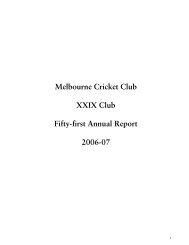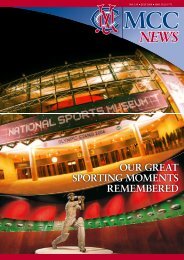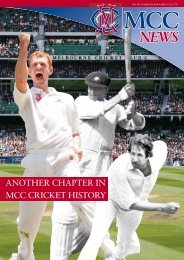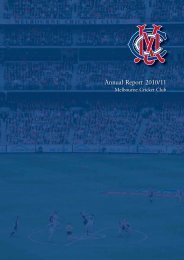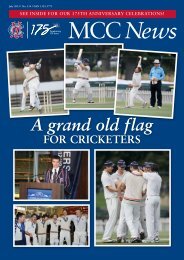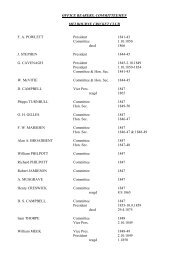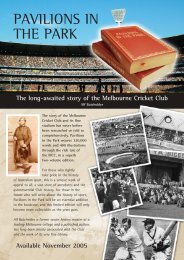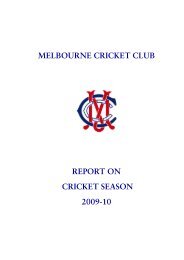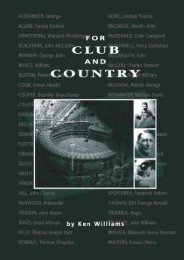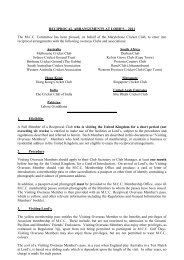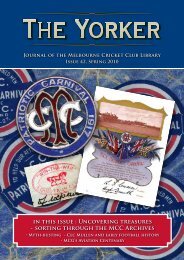Issue 36: Summer 2006/07 - Melbourne Cricket Club
Issue 36: Summer 2006/07 - Melbourne Cricket Club
Issue 36: Summer 2006/07 - Melbourne Cricket Club
You also want an ePaper? Increase the reach of your titles
YUMPU automatically turns print PDFs into web optimized ePapers that Google loves.
The Pavilion ClockIn late November 2004, as part of preparing research for the MCCMuseum and the National Sports Museum’s MCG Exhibition,Library staff and volunteers were comparing documentationon the MCC collection holdings. One item that was listed forinclusion in either exhibition was a large clock, which was thendisplayed in a heritage module of the Great Southern Stand (GSS).This was described as the clock originally displayed on the secondMCC Pavilion, erected in 1881 and demolished in 1927. The clockhad been moved to another stand for 25 years before being storedfor more than 35 years, then cleaned and displayed as a staticobject in one of the MCG heritage modules.A site inspection of the object was required, and after lunchingwith a group of the Library volunteers in the GSS the followingMonday, we headed down to the modules on Level B1 in searchof the clock. Once found, we noted that Roman numeral hourmarkings were faintly visible underneath the present simplemarkings on the face of the clock, showing through from wherethey had been painted over at some time.Upon returning to the temporary library we started to lookthrough old pictures of the clock on the 1881 Pavilion. In thepossession of the MCC Museum are two photographs by W. Lindtof <strong>Melbourne</strong>. These were taken one morning around the timeof the completion of the second Pavilion in December 1881, andshow the first and second Pavilions side by side. (The first Pavilionwould not be demolished until after April the following year, asboth were required for the 1881/82 season tour by Alfred Shaw’sEnglish XI.)It was then that the revelation hit. If the face is the same and thecase looks similar could this clock not just be from the secondPavilion, but also from the first?!? A detailed examination offurther photographs in the Museum and Library collectionsranging from the 1870s to the 1920s revealed the same distinctivenumerals on the clocks on both pavilions. Using scans of the 1881photographs and similar views of the second Pavilion taken onceits clock was installed, it was possible to work out a consistentscale that showed that the clocks not only looked the same, butwere indeed the same size. However, the photos showed that thebacking board of the original wooden casing was wider than thesmall casement on the front of the second Pavilion. It would havehad to be removed from the clock to allow for easy installationonto the front of the second Pavilion.A check of the MCC Committee minutes for 1881 and 1882 for anymention of the clock revealed that the <strong>Club</strong> had originally plannedto sell the 1863 clock and purchase a new one to install on thenew Pavilion. However, the construction costs for the new pavilionwere over the original allocation of £3000 and this had resultedin a reduction of decorative finishings from the original proposal.The minutes also noted that there was no buyer for the old clock,and neither they nor the financial reports reveal the purchase ofanother one. Therefore, it appeared likely that a cost saving wasmade and the clock was simply transferred across from the oldpavilion to the new.With this further evidence making it more likely that the clockmay indeed have been from the first Pavilion, it was decided toseek some authentication from a clock expert, preferably oneaccredited with the Australian Government’s Cultural Gifts andProtection of Moveable Cultural Heritage programs.Ronnie Bauer, of Klepner’s Jewellers and Valuers, fitted the billon all counts. Ronnie was able to verify that the dial and surroundof the clock were indeed consistent with those made in the 1850sand 1860s. He noted that the hands and over-painting on the dialwere actually from the 1920s – also consistent with the originalones remaining with the clock in all of our photographs of thesecond Pavilion up to its demolition in 1927.The photographs revealed a vacant space on the front of the 1881pavilion with a small casement housing awaiting the fitting of aclock, while the original pavilion still retained its clock, shownsitting flush against the face of the arched gable built to containthe clock and its mechanism in 1863. A magnification of this clockon the 1854 pavilion clearly showed Roman numerals aroundthe face. Indeed they were so clear that they almost leapt off thephotograph, the distinctive IIII for the 4 instantly reminding usof the faint numerals that had been seen less than a half-hourearlier on the clock in the heritage module.The Yorker - <strong>Summer</strong> <strong>2006</strong>/<strong>07</strong>



